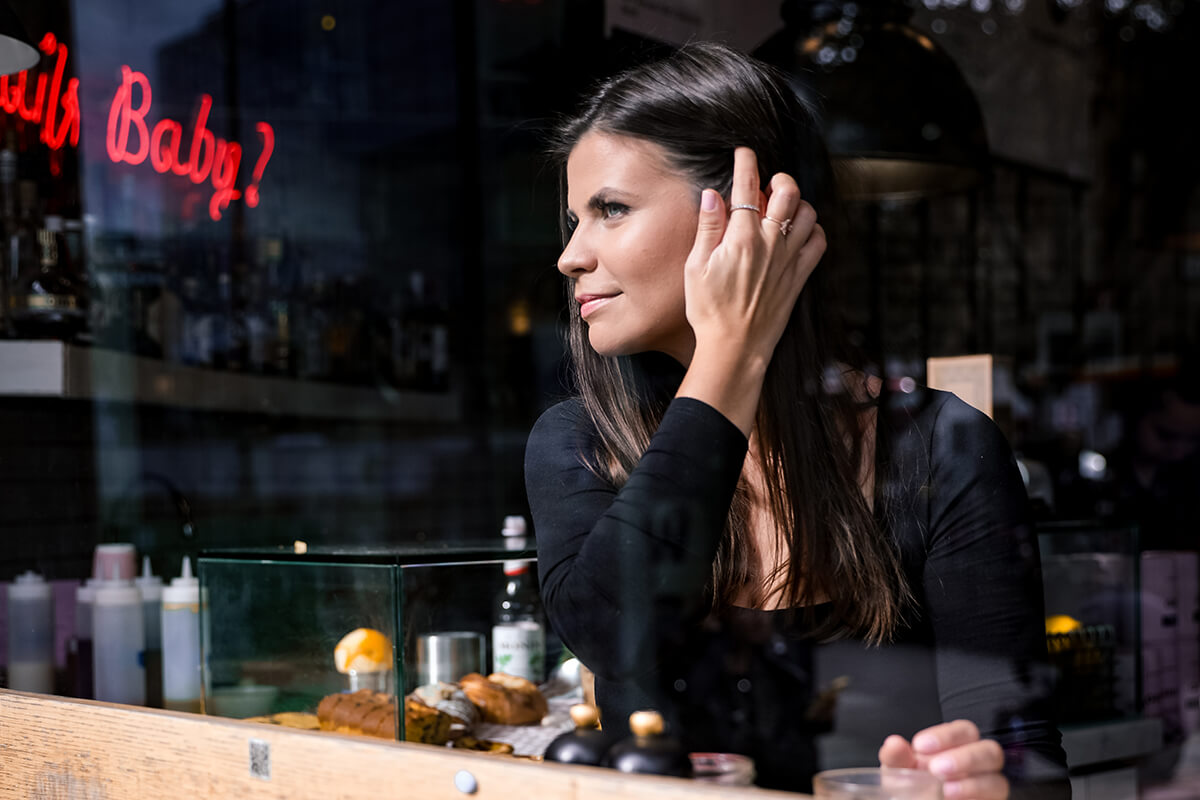Head of Planning – Petra Kovacs

Name: |
Petra Kovacs |
Role: |
Head of Planning |
Company: |
Swarovski UK |
Website: |
|
Time with the company: |
3+ years |
What is your morning routine?
I start my day with a nice cup of latte, whilst reading through The New York Times morning briefing on my ipad. I like my mornings slow and peaceful and would always leave enough time to comfortably get ready for work. I also exercise at least 3 times a week, which fills me with good energy for the day ahead.
How did you get the job / how did you become involved with the industry?
I always say that I didn’t choose Merchandising to be my profession, Merchandising chose me – and it’s still one of my favourite stories to tell.
I was working as a marketing assistant at a property development company back home in Hungary. One day I accidentally saw a job advert for a Marketing Manager position at Puma in Budapest. I’ve been into sports in my entire life and always dreamed of working for one of the big sportswear brands.
Their local offices tend to be small with limited number of employees, so these brands hardly have any openings. And whilst I wasn’t experienced enough for the advertised position, I thought it was a once in a lifetime opportunity to get in touch with the brand and tell them how much I’d like to work for them. I didn’t hear back for about 4 months. Then one day there was a reply in my mailbox which I didn’t even open for 2 weeks! I assumed it was the usual “thanks for applying, we chose someone else” message… well, it wasn’t. It was Puma asking me for an interview after reading my heartfelt message about how passionate I was for their brand. They had an opening for a receptionist position, and they asked if I was interested. Well, I wasn’t really interested in the position, but… only because it was Puma, I said yes.
During the interview we had a great chat about the Dassler brothers (I was writing my university thesis about adidas’ Impossible is Nothing campaign at the time, so I was very aware of the company’s history), football, clothes and excel – all the things I was passionate about. At the end, my future GM said: “I think you’d make a good product merchandiser”. I signed my contract the same day.
A year later Puma relocated me to Prague. Another year later I moved to the Headquarters in Germany to join the European Merchandising team. Another 18 months later, I was asked if I was interested in heading up the apparel merchandising team in London. I don’t think I hesitated even for a second.
I stayed in that position the longest, however after a total of 7 years with the brand in product merchandising, it was time for me to move on and expand my portfolio to retail planning. I was also keen to experience a different product category, so I was thrilled to accept a position in Demand Planning at Swarovski at the begging of 2018.
I find it fascinating how my first GM at Puma saw something in me that I had never known existed. I’m beyond grateful for the opportunities that followed after I accepted my first role, but I’d also like to think that he was right back then: I do make a good merchandiser.
What is your main responsibility?
In my current position I manage everything that is the number side of the product: financial and purchase budgeting, allocations, orders, weekly replenishment, sell-through, weeks of cover, weekly product reports, promotional strategies – all the sexy stuff.
My team’s single most important task is to deliver the right product at the right place and right time – which is often easier said than done. I believe that our function tends to be a little underrated, because we’re the invisible hands in the background. When everything goes smoothly, no one notices we are even there – but when things turn tricky, we are in the forefront to firefight and that is our moment to think outside the box and deliver clever solutions.
What is your typical day like?
Monday is the most important day for us, and it is the one with the most structure. On a typical Monday my team would prepare and present the category performance report of the previous week, so we can discuss product risks and opportunities with the wider business, especially with the sales team. After analysing the sales data and receiving qualitative feedback from the field (both the sales teams and stores), we agree on our priorities for the week. The following day I sign off the replenishment order my allocation team proposes – including any VM quantities, manual uplift orders, re-distributions between stores and outlet transfers.
The rest of the week is mainly for executing other priorities and supporting the business with product-related tasks. Depending on what planning phase it is, our focus needs to switch between in-season trading and future planning, such as budgeting, forecasting or product review meetings either in person in our Swiss HQ or on Teams.
Please explain what the structure is in a typical Merchandising team and the relationship Merchandising has with the Buyers
Depending on what retail brand you work for, merchandising, planning and buying are defined slightly differently. In a typical set-up the team would have lots of different layers with plenty of opportunities to progress in one’s career – starting from Allocators, Assistant Merchandisers and Junior Merchandiser to Seniors, Team Heads then Head of / Director of Merchandising and Buying.
In a wholesale environment a Product Merchandiser is responsible for both assortment planning, which is technically “the buy” for the season, as well as the financial forecast for each product.
In a retail business like Swarovski, a Buyer creates the product plan (each and every product range that goes to a specific store based on store capacity/space/linear meters) and the Merchandiser/Planner puts the buy budget behind that assortment of product. To understand what this looks like in real life: my Buyer tells me the Merchandiser that she selected 1 necklace in 2 different colours for our Oxford Street store. I then decide how many units of these necklaces we send to the store and how much profit that will generate based on sales and product analysis.
What’s the best part of your job?
What I enjoy most about retail planning in general is that I can see the result of my decisions within a very short timeframe. Retail is super fast-paced so I need the ability to read data quickly and react promptly to burning topics. And because we trade every day, we also see our sales results every day – increased sell-out could be the very result of a decision me or my team made which is just fantastic to see. As we often say “In retail you’re as good as your last week’s numbers”, which I always keep in my mind to keep pushing for better results.
At Puma, as a wholesale product merchandiser my most exciting responsibility was to secure the right product assortment for my markets for the coming season. I needed to make sure that we had the right styles and colours offered at the right price points for key accounts like JD Sports, Sportsdirect or ASOS. Product merchandising needs a slightly different set of skills that are mainly market-knowledge based. We always worked almost 1 year ahead of the season, so everything I was doing was for the future.
What I love the most about working in product in general is that I see the future trends and collections before anybody else.
What’s the worst part of your job?
I wouldn’t say there is a worst part. Maybe there is a “most uncomfortable” part which is the fact that we always have to be alert and wait for the unexpected. Merchandising is in the heart of any retail business, because it delivers the product – without us, there would be no product to sell on the shopfloor. In the “Idea to shelf” process we are right in the middle: assorting, pricing, forecasting, allocating, replenishing, discounting each and every product individually for a lot of locations across the country. I manage 1,200 full price SKU’s for 65 stores in the UK currently, which generates over 80,000 different SKU/Store combinations. Imagine checking 80,000 lines in an excel file individually each week in order to ensure each and every product delivers what we expected. When you deal with such high numbers and many different stakeholders who are crucial for achieving overall success – production, warehousing, order fulfilment, shipping partners – there is always risks for unexpected situations. And we always need to be flexible and ready to solve them.
What’s your most memorable work moment?
Oh, there are so many. With Puma there was never a dull moment. Still vividly remember the day when Usain Bolt, Lewis Hamilton or Rihanna showed up in the office. When you’re passionate about sports and you’re lucky enough to work for a sportswear brand, it is beyond inspiring to hear World and Olympic Champions tell you how your products help them achieve better results. You feel like you’re a part of something amazing.
On a very personal level, the one memory I often think back of when I need a little boost, is when I was awarded the Managing Directors’ Award by my Swarovski MD’s. They choose me because they felt I had made an outstanding contribution to the business in the last 12 months by keeping all of our stores fully stocked, which evidentially contributed to our financial growth. It is a fabulous feeling to be recognised for your efforts by your leaders and something that inspires and sets the bar for all my future contribution to the business.
What advice would you give to anyone interested in the same profession?
Merchandising, Planning and Buying are all based on industry and market knowledge. Therefore, I’d recommend spending a lot of time on the high street or preferred shopping locations, visiting stores, talking to store staff or following brands on social media. It’s important to know what different brands offer, what their Unique Selling Point (USP) is and who their target customers are. During a typical interview for any of these positions at any given brand, the interviewer would question your market knowledge to see how engaged you are with the field.
If anyone has a favourite brand they’d like to work for, I’d recommend following them on LinkedIn and keeping on eye on their job openings.


